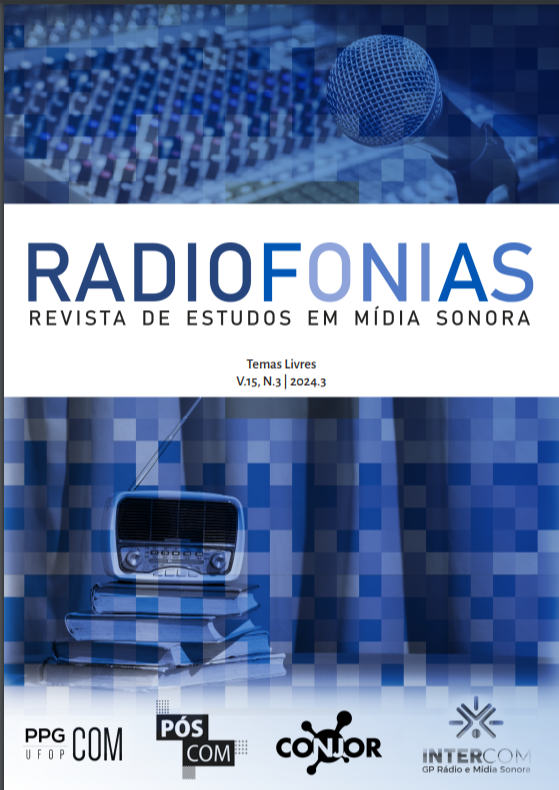Far away from a sound culture? Horizons for the use of sound as a media literacy tool
Abstract
Culture tends to be more visual than exclusively audible, but this is not a particular feature of the present times. There are clear signs that are perfectly consistent with the idea that Western societies tend to see more than actually hear. This article is inspired by this general assumption as a way to address the significant role of sound as an educational and cultural element, while presenting some experiences of promoting education for the media through sound formats. Thus, it was concluded that when academics and researchers intend to address issues that arise in the sound sphere, with specific audiences, they typically approach this subject from the classical structure of radio programming. As for media literacy strategies, using sound formats, it seems clear that the Public Broadcasting Service is the only one promoting some kind of discussion about the media agenda.
References
BRADEN, C. Acoustic tourism –an emerging industry. Comunicação apresentada no Congresso “The Global Composition. Sound, Media, and the Environment Darmstadt”, Dieburg, 2012.
BRITES, M. J., AMARAL, I., SILVA, M. T. Literacias cívicas e críticas: refletir e praticar. Braga: Centro de Estudos de Comunicação e Sociedade da Universidade do Minho, 2019.
BRITES, M. J., JORGE, A., SANTOS, S. C. Metodologias participativas: os média e a educação. Covilhã: Labcom Books, 2015.
EISNER, E. The arts and the creation of mind. New Haven: Yale University Press, 2002.
FLÜGGE, E. “Silent sonorities and unsound acts”. Sound Studies, v. 4, n. 1, 2018.
GAJRAJ, A. “A Regional Approach to Environmentally Sound”. Tourism Recreation Research, v. 13, n. 2, 1988.
LAPPIN, S., OUZOUNIAN, G. “Soundspace: A Manifesto”. Architecture and Culture, v. 2, n. 3, 2014.
LEE, D., HATESOHL, D. Listening: Our Most Used Communication Skill. Missouri: University of Missouri-Columbia, Extension and Agricultural Information, 1993.
LLINARES, D., FOX, N., BERRY, R. (eds.). Podcasting: New Aural Cultures and Digital Media. Londres: Palgrave Macmillan, 2018.
LONG, P. “Popular music, psychogeography, place identity and tourism: The case of Sheffield”. Tourist Studies, v. 14, n. 1, 2013.
MARTINS, M., MIRANDA, J. B., OLIVEIRA, M., GODINHO, J. (eds.). Imagem e Pensamento. Coimbra: Grácio Editor, 2011.
MOURÃO, M., PEREIRA, S. “Rádio e Educação para os Media: dinamização de um ateliê de comunicação radiofónica em contexto escolar”. Observatorio (OBS*) Journal, v. 12, n. 4, 2018.
OLIVEIRA, M. “A história surda dos estudos de rádio e os desafios da investigação sobre as significações do ouvir”. Significação, ano 40(39, 2013.
OLIVEIRA, M. O excesso de luz e a fragilização do ouvido. In M. OLIVEIRA & S. PINTO (Eds.), Atas do Congresso Internacional Comunicação e Luz (pp. 329-336). Braga: Centro de Estudos de Comunicação e Sociedade da Universidade do Minho, 2015.
PEREIRA, S, Pinto, M., Madureira, E., Pombo, T., Guedes, M. Referencial de Educação para os Media para a Educação Pré-escolar, o Ensino Básico e o Ensino Secundário. Lisboa: Ministério da Educação e Ciência, 2014.
RHEINGOLD, H. “Using Participatory Media and Public Voice to Encourage Civic Engagement." In W. Lance Bennett (ed.) Civic Life Online: Learning How Digital Media Can Engage Youth (pp. 97–118). Cambridge: The MIT Press, 2018.
RIBEIRO, F. Opinião pública nos média em Portugal: quem participa e porquê?. Braga: Centro de Estudos de Comunicação e Sociedade da Universidade do Minho, 2017.
STREET. S. Sound at the Edge of Perception. The Aural Minutiae of Sand and other Worldly Murmurings. Singapura: The Gateway East, 2019.
THOMPSON, E. The Soundscape of Modernity: Architectural Acoustics and the Culture of Listening in America, 1900–1933. Cambridge, MA: MIT Press, 2004.


